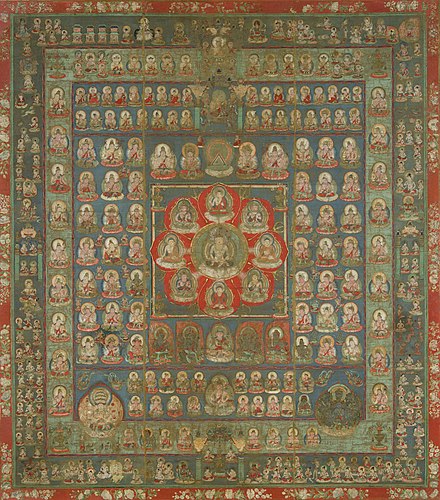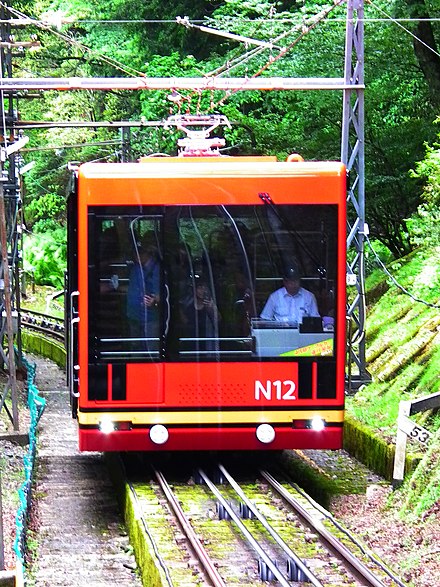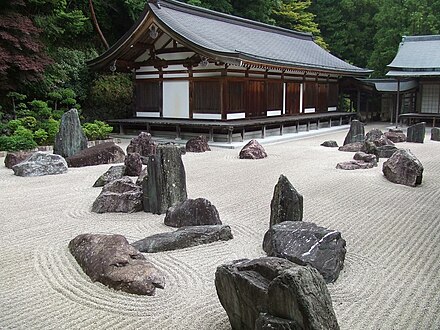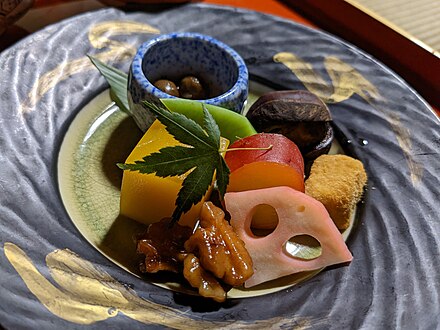Mount Koya - Buddhist temple complex and settlement in Wakayama Prefecture, Japan

Mount Kōya (高野山, Kōya-san) is a mountain in Wakayama prefecture to the south of Osaka, Japan, primarily known as the headquarters of the Shingon sect of Japanese Buddhism.
Understand
First settled in 816 CE by the monk Kūkai as a retreat far away from the courtly intrigues of Kyoto, Mt. Koya is located in a 800-m-high valley amid the 8 peaks of the mountain. The original monastery has grown into the town of Koya, featuring a university dedicated to religious studies and over 100 temples, many of which offer lodging to pilgrims.
In 2004, UNESCO designated Mt. Koya as part of a wider World Heritage Site.
If you stay in Osaka, you can consider visit Mount Kōya on a day trip (leave early in the morning and allow the time to reach Osaka Namba station and buy your ticket). If you can, though, it's worth it to spend the night in one of the numerous temples (see section "Sleep"), which will give you the opportunity to immerse yourself a little deeper in temple life and also experience a classical Japanese inn at a reasonable price.
Doctrine and symbolism

Unusually in Japan, Shingon descends from the tantric Vajrayana lineage of Tibetan Buddhism. Most Japanese schools of Buddhism like Zen contend that scriptures and practices are merely guideposts on a long and arduous path to enlightenment, but Shingon contends that anyone can reach enlightenment in their lifetime by focusing on esoteric practices that aim to communicate Dharmakaya, the "truth-body" where the universe and Buddha-nature are one, directly. These key Shingon practices, known as the Three Mysteries (三密 Sanmitsu), are mantra (sacred sounds), mudra (sacred gestures) and mandala (sacred maps).
The uniquely Shingon goma (護摩) fire ritual, performed daily at most Shingon temples with the accompaniment of taiko drumming and hypnotic chanting, is particularly well-known. Believed by adherents to have a powerful spiritually cleansing effect, it can certainly be trance-inducing, particularly if you're still groggy after being woken up at 5 AM to attend it! Colorful mandalas decorate Shingon altars, and Mt. Koya itself forms the focal point of a giant mandala spanning all of Japan.
When to go
Mount Koya is sufficiently high up to be noticeably cooler (3-5°C) than Osaka. Cherry blossom season comes here a few weeks later than the lowlands, typically around mid-April, while fall colors (紅葉 kōyō) around October are also a major tourist draw. Summers are still hot and muggy, while winters are cold enough to support considerable snow: fun for sledding kids, less so when shivering in a temple built from wood and paper.
Tourist information
The Kōyasan Shukubō association has two information centers. Here you can rent excellent audioguides (¥500/person/day), including in English and French. They describes various sites including temples and tombs, and make the visit much more interesting.
- Center office. 08:00-16:30. 2016-05-05
- Ichi-no-hashi office. 08:00-16:30. 2016-05-05
Get in
By train
Most visitors arrive on the Nankai Electric Railway from Namba Station in Osaka, which connects to Gokurakubashi at the base of the mountain. Koya (こうや) limited expresses with reserved seats take 80 minutes and cost ¥1650, while ordinary expresses are lower priced at ¥870 and take 10-20 minutes longer with a change of trains possible. There's not much to look at during the first half of the trip (although keep your eyes peeled for the surreal PL Peace Tower, in the middle of the fields to your left before Kongō stn), but the second half of the trip after Hashimoto is a slow climb up into the mountains and extremely scenic in good weather.
 A cable car from Gokurakubashi then whisks visitors to the top in 5 minutes for ¥390. From the cable car station you'll have to take a bus to town (5-15 minutes depending on your destination). Train, cable car and bus schedules are synchronized.
A cable car from Gokurakubashi then whisks visitors to the top in 5 minutes for ¥390. From the cable car station you'll have to take a bus to town (5-15 minutes depending on your destination). Train, cable car and bus schedules are synchronized.
A good value way to reach Koya-san is to purchase the 2-day Koyasan World Heritage Ticket available from the Nankai ticket counter. At a cost of ¥2860, the ticket includes one round trip on the Nankai train and cable car, a two-day Koyasan bus pass, and discounts at certain attractions, shops and restaurants. A version of the ticket that includes the trip to Mount Koya by limited express costs ¥3400.
From March 1 to November 30 the Koyasan One Day Ticket (高野山 1-day チケット) may be purchased. This is similar to the ticket above but also includes connection to a single private railway via the Osaka Subway. Sample fares include: Hankyu (¥3090), Hanshin (¥2980), Keihan (¥2100), and Kintetsu (¥3070).
The regional Kansai Thru Pass can be used on regular Nankai Railway trains and the Cable Car all the way up to Mount Koya, and can be used on the Koya-san buses as well.
The closest JR train station is at Hashimoto, which is a transfer station to the Nankai Railway. From here it takes 40 minutes and costs ¥440 to reach the cable car station at Gokurakubashi by local Nankai service. Japan Rail Pass holders can easily access Nankai trains at the Shin-Imamiya (新今宮) station of the JR Osaka Loop Line, from which the fares for trains and the World Heritage Ticket are the same as from Namba. From Kyoto, rail pass holders can take the Kyoto Line Special Rapid train to Osaka station, then change to the Osaka Loop Line to Shin-Imamiya.
By bus
If coming from Kyoto, a faster and easier option is Keihan Bus, which runs one service daily from Kyoto Station, stopping at Okunoin-mae and Koyakeisatsu-mae. The trip takes just under 3 hours and costs ¥2600/4700 one-way/return.
By car
If you have your own set of wheels, you can also head east towards Ise or south to Ryujin Onsen and southern Wakayama. Both roads are small and there is no public transportation, but daring souls might try hitching.
On foot

Before the train and cable car connection, which was built in the early 20th century, the only way to reach Mt. Koya was via the ancient pilgrim trail called the Chōishi-michi (町石道) which is still maintained and marked with stone pillars every chō (about 108 meters) - these have given the trail its name. The trail is about 22 km long, ascends about 700m, and is just about doable in a single long day. See its starting point, the town of Kudoyama, for details.
If you're in the mood for more pain, the pilgrim trail continues south from Koya as the Kohechi (小辺路) trail of the Kumano Kodo. Some 70 km long, this route is for serious hikers only: it crosses four remote mountain passes with over 1,000 meters of elevation gain, has minimal facilities, and is usually tackled over 4 days. Tanabe City Tourism has detailed maps (Japanese only) of the route, broken into four stages.
Get around
You can get from one end to the other of the village on foot in 30 minutes, but regular buses allow you to save time.
Nankai Rinkan Bus operates the buses around Mount Koya. Passes such as the Koyasan World Heritage Ticket and Kansai Thru Pass (see By train) provide unlimited use. Otherwise board buses using the rear door, take a ticket when you board, and pay the fare based on the display at the front of the bus when you exit. A one day bus pass, sold at the Koyasan cable car station, costs ¥830.
See

Mount Koya's sights are mostly clustered at the west end of town near Danjō-garan, and at the east end near Okunoin. You can cover most of them pretty comfortably in a single day, which is convenient since everything closes around 17:00.
Danjō-garan and surroundings
-
Danjō-garan (壇上伽藍), 152 Koyasan, 34.21292°, 135.58044°. 08:30-17:00. It is a temple complex designed by Kukai on the western side of town. One notable temple in the complex is Miedo which holds Kobo Daishi's staues, it is considered Mount Koya's most elegant building due to it gentle sloping roof. In the complex's center is the Konpon Daitō (根本大塔) pagoda, which according to Shingon doctrine represents the central point of a mandala covering Mt. Koya and all of Japan. Beside the pagoda is the Kondo Hall where many ceremonies are held. Free for access to the temple ground, ¥500 for the Konpon Daito Pagoda or the Kondo Hall (¥1,000 for both) 2016-05-05
-
Kongōbu-ji (金剛峯寺), 34.21399°, 135.58395°. This temple is the sprawling yet atmospheric headquarters of the Shingon sect. The Banryūtei stone garden here is Japan's largest and outclasses many of Kyoto's best, and there's also a remarkable series of sliding wooden panels painted in gold depicting the journey of the Buddha. Free tea at the Shinden hall, and daily ajikan meditation lessons (¥1000). Entry ¥1000 (20% discount with the Nankai Pass) 2022-10-03
-
Reihokan Museum (霊宝館, Reihōkan), 34.21127438056302°, 135.58117365557376°, +81 736-56-2254. 08:30-17:30, closed on new years. Museum that houses many of Mount Koya's treasures. The museum is style after Byodoin in Uji. ¥1300, ¥1100 if you hold the Koyasan World Heritage Ticket or Kansai Thru Pass 2021-12-22
-
Daishi Kyokai (大師教会), 347 Koyasan, 34.212291330766426°, 135.58226228389893°, +81 736-56-2015. 08:30-17:00 (entry closes at 16:30). The administrative center of Shingon Buddhism. Various Buddhist activities are offered at the hall such as copy scriptures and meditation. ¥1000, free with combo ticket 2021-12-22
-
Daimon (大門), 34.21318507491179°, 135.57286222653283°. Open at all times. Large gate considered the main entrance to Mount Koya. Two statues in the gate guard the town. 2021-12-22
-
Nyonindo (女人堂), 709 Koyasan (1 km north of the main town), 34.21997503879937°, 135.58090916127716°, +81 736-56-3508. 08:00-17:00. Until 1872 women were forbidden from entering Mount Koya's main town. During that time a collection of temples outside the town center were the only place were women could worship. Only one of these temples remains; it is visited by many women. 2021-12-22
-
Tokugawa Mausoleum (徳川家霊台, Tokugawa-ke Reidai), 682 Koyasan, 34.2174212603661°, 135.58315154965516°. 08:30-17:00. Built by Tokugawa Iemitsu in 1643, this is one of numerous mausoleums in Japan dedicated to the Tokugawa Family. It took 20 years to complete and enshrines Tokugawa Iemitsu, the third Tokugawa Shogun. ¥200 2021-12-22
Okunoin and surroundings
Mossy, ancient and serene, Okunoin is perhaps the top draw on Mount Koya, particularly if you visit early or late in the day when it's quieter or take even a few steps off the beaten path. This is where Kobo Daishi, the founder of Shingon Buddhism is buried, and what is now Japan's largest graveyard has grown up around it.
Okunoin is only accessible by foot and there are two main routes to visit Okunoin from Mount Koya's main town. The first route is considered more traditional but requires more walking while the second route is done by most modern visitors and requires less walking. The first route begins at Ichinohashi-guchi Bus Station 📍 visitors will first cross the Ichinohashi Bridge where one should bow. This route continues through sacred forested cemetery before arriving at the main complex. This route takes 2 km. The second route begins at Okunoin-Mae Bus Station 📍 and takes less than 1 km to reach the main complex. It passes through the cemetery's modern areas and is also busier. Both routes converge at Gokusho Worship Hall where one can continue to the Mausoleum. Many visitors choose to take the first route on the way there and the second route when returning to the main town. The following sites are listed in the order they will be visited if following either route.
- Okunoin Cemetery (奥の院墓地, Okunoin bochi), 34.21817°, 135.60467°. Japan's largest graveyard, with some 200,000 graves, is set among giant cedar trees with winding paths throughput. The closer you get to Kobo Daishi's mausoleum, the older and mossier the graves get. On your way back, if going via the second/shorter route, keep an eye out for some whimsical corporate gravestones, including UCC's coffee cup, Yakult's drink bottle, Shin-Maywa's rocket and many more. 2016-05-05
- Gokusho Worship Hall (奥の院 御供所), 550 Koyasan, 34.22150631543625°, 135.606114894352°, +81 723-56-5616. 08:30-17:30. Worship hall where visitors can make offerings to various deities. Visitors are also encouraged to throw water at the statues, while praying to departed family members. Free 2016-05-05
- Tōrōdō (Hall of lanterns, 燈籠堂), 550 Koyasan, 34.222940°, 135.605741°, +81 736-56-2002. 06:00-17:30. Okunoin's main worship hall where over 10,000 lanterns are kept eternally lit. The hall also features 50,000 statues kept in the hall's basement. Free 2021-12-22
- Kobo Daishi's Mausoleum (弘法大師御廟, Kōbō-daishi-gobyō), 132 Koyasan (just behind Torodo), 34.223254°, 135.605743°. Mausoleum where Kobo Daishi, the founder of Shingon Buddhism was buried. Pilgrims come from all over Japan and many who finish the 88 Temple Pilgrimage visit the mausoleum after their pilgrimage to thank Kobo Daishi. Visitors may not enter the mausoleum but many visitors burn incense and chant sutras in front of the Mausoleum's entrance. When crossing Gobyo-bashi bridge, the final bridge before Mausoleum make sure you bow as its considered disrespectful if you don't. Food, drink and photography are also prohibited past the bridge. 2021-12-22
- Ochadokoro (Shotokuden) (御茶処・頌徳殿), 34.2212°, 135.6062°. On your way out, stop at this little pavilion for a cup of tea, which you can ladle out yourself from the large bronze cauldrons kept simmering in the back. The tea is free, but there is a conveniently placed donation box nearby. 2022-10-03
Do

Hiking around Mount Koya is a good option. Among many courses, there is one that starts at Daimon (大門, big gate), hiking up to a tiny shrine at the top of Bentengaku (弁天岳), and then down to Nyonindou (女人堂). Not a difficult hike, and should take only a couple of hours, depending on how often you stop on the way to take photos. You can encounter a few species of lizards and snakes along the way, such as jimuguri (ジムグリ, Japanese Forest Ratsnake), the Japanese five-lined skink, and the Japanese grass lizard. From the top you can see all the way south to Wakayama City and the ocean.
Eat


All temple lodgings on Mt. Koya offer Shōjin ryōri (精進料理), purely vegetarian food intended for monks. People who equate vegetarian food with blandness will be surprised: in their hundreds of years of experience with vegetarian cooking, the monks have invented amazingly tasty dishes. A local specialty, Kōya-dōfu, is prepared by freeze-drying and then reconstituting tofu, turning into a spongy block.
- Bon-on-sha (梵恩舎), 34.2128°, 135.5890°. 6:30 AM-5 PM. On the left hand side of the main road as you walks from the centre of town to Okunoin cemetery, 150 m from the main traffic lights. This cafe and art gallery specialises in organic vegetarian lunches (price varies depending on contents of set. ¥800-1200). The menu changes daily, and a number of homemade cakes are available, as are coffees and teas (¥300). The couple who run the cafe are collectively native speakers of French, English and Japanese and also fluent in Italian and Mandarin Chinese. One of the few places in Koya-san that open early. 2022-10-03
- Hanabishi (花菱), 34.2128°, 135.5870°, +81 736-56-2236. This classy restaurant has been serving customers for over 120 years and is a good option for sampling Buddhist vegetarian fare if you're not staying overnight. A shōjin ryōri lunch set runs ¥2100, while a full-on multi-course vegetarian kaiseki experience runs ¥5000-10,500 (cheaper at lunch). Some of the Bento sets are not vegetarian, so stick with shōjin ryōri for the "real thing". 2022-10-03
For those unwilling to eat vegetarian, a number of restaurants offer regular Japanese and Chinese cuisine. There are also many reasonably priced izakaya around the center of town that offer a range of many traditional Japanese pub foods. Check opening hours: many places are open for lunch or dinner, but not both.
- Hachiyo (はちよう), 34.2163°, 135.6046°. 10 AM-5 PM. The primary selling point of this all-round Japanese eatery is its perfect location right next to the Okunoin-mae bus stop and the start of the Okunoin trail, but the food is a cut above the average shokudo. Try the sansai soba noodles with mountain vegetables, made from fresh vegetables instead of the usual prepacked mix. From ¥800 2022-10-03
- Inoue (いのうえ), 34.2152°, 135.6053°. Near the Okunoin-mae bus stop. Boasts the largest Omu-Rice (omelette filled with rice and some meat) in Japan, ¥550. English menu available. From ¥800 2022-10-03
- Miyasan (みやさん), 34.2128°, 135.5862°. 5:30-8 PM. Centrally located in the middle of Koyasan, just South of the main traffic lights, it has a menu of about 50 items ranging from ¥200-1000. The inn's banner states that its specialty is fried chicken, although all the items are of high quality. The Ramen is particularly filling. English Menu available. 2022-10-03
Sleep
Temple lodging

About half of the over 120 temples in town offer lodging for pilgrims, known as shukubō in Japanese. Prices vary between ¥9,000 and ¥15,000 per night per person and include two fully vegan meals. You will be offered the opportunity to join in the morning prayer session (お努め o-tsutome), a hypnotic experience involving sutra chanting, incense and gongs.
While the monks don't drink, alcohol may be available to guests at dinner, and perhaps even from a vending machine. Temples have set hours at which the front gate is opened and closed, and the time the bath is available. This curfew can be as early as 21:00, so don't expect to head out after dinner — although you'll want to go to bed early anyway if you want to attend the morning prayers, which can be as early as 05:00! Breakfast and check-out times are also geared for early risers.
You can book directly with the major temples, or via the official Koya-san shukubo association reservation service. Outside the main season, you can just show up at the Koya cable car station and book from there, but generally reservations are preferred.
- Daienin (大圓院 or 大円院), 34.2130°, 135.5894°, +81 736-56-2009. A fairly typical temple, centrally located (walking distance to both ends of town) and run by a friendly bunch of monks who know a little English. Large breakfasts (07:10) and dinners (17:30) are provided by the monks, who retrieve you from your room when the meals are ready. They will also come to get you in the morning for morning worship (05:55), so be awake and ready! Temple curfew is 22:00 by the sliding door although the main gate closes at 18:00. ¥11340 2016-08-24
- Fukuchi-in (福智院), 657 Koya San, Koya-cho (1 min on foot from Keisatsusho-mae stop), 34.2167°, 135.58544°, +81-736-56-2021. Check-in: 3 PM, check-out: 9 AM. This 1200-year-old temple features the only hot springs (onsen) in Koya, with indoor and outdoor baths open 24 hours a day for guests only (no day tickets). Only vegetarian dishes are served here, and the meals, which feature seasonal ingredients, are painstakingly planned and prepared by the head chef with a different course every month. On the downside, this is also one of the largest operations at Mount Koya, so it feels much more like a regular ryokan than some of the smaller temples. Centrally located next to Kongobuji. from ¥12,500/person 2022-09-10
Other options
- Koyasan Guest House Kokuu (高野山ゲストハウスKokuu), 49-43 Itogun, 〒648-0211, 34.2160°, 135.6064°, +81 736-26-7216. Modern capsule style guest house. Price is ¥3,500 per capsule room, ¥6,000 for single room and ¥9,000 for double (more expensive on weekends) ¥11340 2016-08-24
Stay safe
If choosing to take the hike up from Kudoyama, in addition to the regular hiking precautions, consider that roughly 1 km of the course runs directly beside a golf course. In addition to stray balls (wear a hat), it seems the owner may be fighting an insane one-sided border dispute because, as of June 2010, around where the trail doubles as an access road, somebody has installed a couple of electrified tripwires over the trail, which appear to be hooked up to the golf links. Be aware.
An otherwise complete set of localised advisories can be found on the English or Japanese hiking maps available at the temple at the very start of the course.
Go next
Many of the pilgrims visiting Mount Koya are on their way to start the 88 Temple Pilgrimage on the island of Shikoku or continue the pilgrimage to the Kumano Sanzan and Ise Shrine.
Not far outside Koya, approx. 15 min by car, is Otaki, a small town aptly named for the large waterfalls at its entrance. Once past Okunoin, take the Ryujin Skyline towards Shirahama and look for a small sign about 15 min down the road. The entrance should be on the right. Take the small road downward for about 2 minutes and the 2 large waterfalls should be visible from the road. It is an especially nice place to stop and have a picnic before leaving Koya.
Mount Kōya
Postal code:648-0211Date Time:Please wait...Timezone:Asia/TokyoCoordinates:34.22, 135.58
Ito-gun
2nd-order administrative division
Wakayama Prefecture
Primary administrative division
